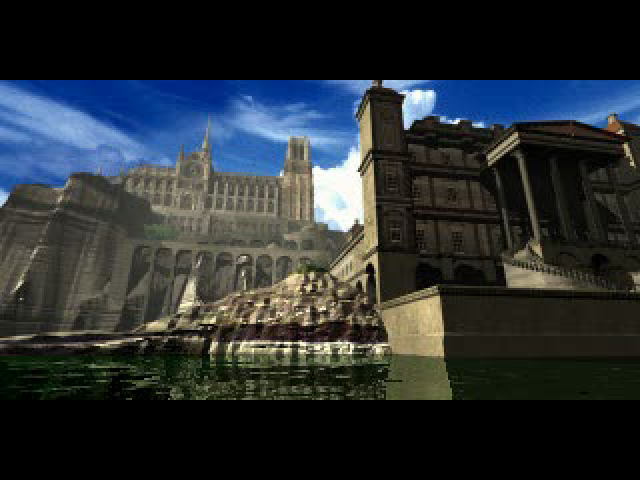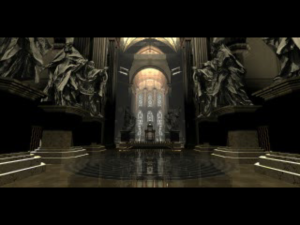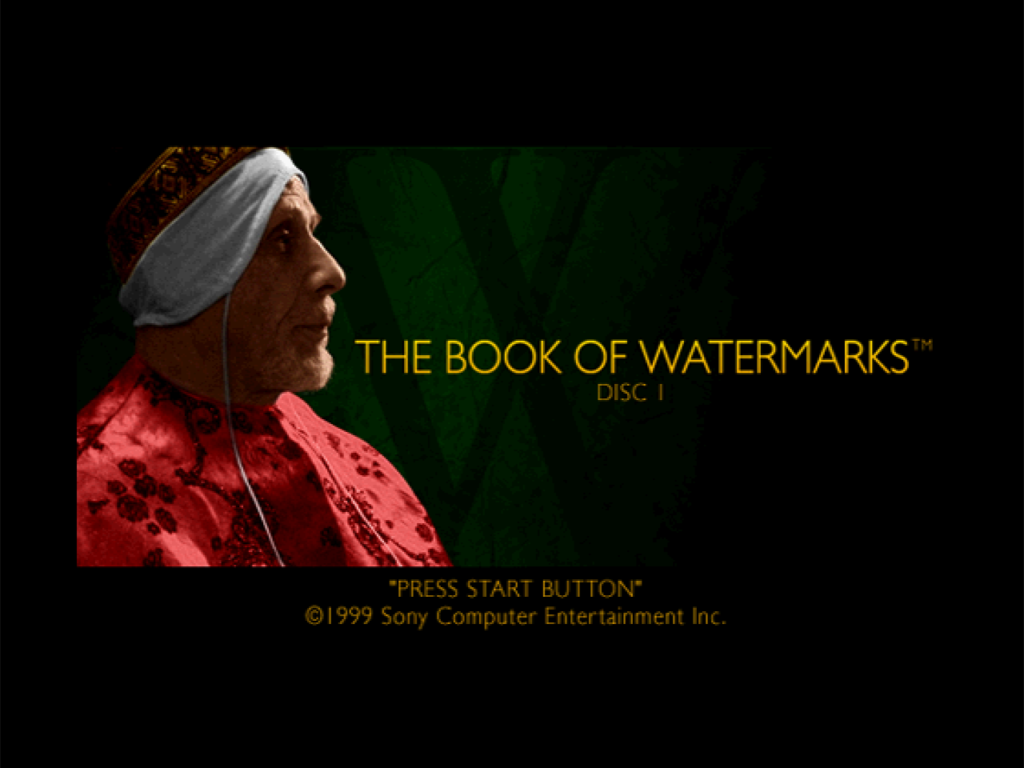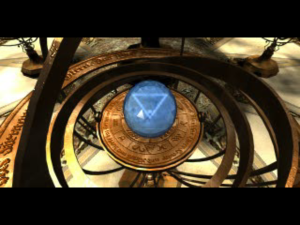The Book of Watermarks 

There was a commercial that aired constantly on TV in the mid-late-90s for Pure Moods, a compilation album of new-age and world music, featuring artists like Enya and Enigma. The commercials promised not just an album but an experience that transported you to a higher realm of inner peace and pure vibes. It was “the soundtrack for your way of life,” the announcer intoned in a deep, breathy voice. Also, for some reason, it had a rave remix of the X-Files theme song.
The Book of Watermarks feels like Pure Moods taking physical form and becoming an entire world. The setting of this 1999 PlayStation game — released exclusively in Japan but mostly in English with Japanese subtitles — is a sprawling Mediterranean villa with gargantuan cathedrals, libraries, and catacombs. Key music was co-composed by Moya Brennan, a musician best known as the lead vocalist of the new-age Celtic band Clannad, in which she briefly performed with her sister, Enya. Brennan’s non-lyrical vocal themes fade through a synthesized orchestra as the camera sweeps across the rocky shores of the islands. The whole production feels gauzy and dreamlike. I don’t think it’s coincidence that the game shares its name with Enya’s dreamy, breakthrough 1988 album Watermark.
What director Takashi Kobayashi and his team created isn’t exactly a living new-age album though, just like it isn’t exactly an adventure game, or an attempt at a cautionary tale about the internet, or a loose adaptation of The Tempest. Remarkably, The Book of Watermarks is all those things, to varying degrees. What they really created is an ornate puzzle box, one that’s more about a sense of place than it is about the puzzles themselves.
It wouldn’t be quite right to say The Book of Watermarks is actually an adaptation of Shakespeare’s The Tempest. The game borrows the play’s central character, Prospero, a powerful sorcerer and the rightful Duke of Milan, whose ship crashes on the shores of a mysterious island. Beyond that, they have about as much in common as Team of Rivals has with Abraham Lincoln: Vampire Hunter.
Instead, the designers took their inspiration from a more unusual source: Prospero’s Books, an experimental non-narrative film from 1991 by Peter Greenaway, itself loosely based on The Tempest. Greenaway’s film imagines an elderly Prospero, having spent his twelve years in exile cultivating a library for his beloved books of magic, and asked a question outside the scope of Shakespeare’s script: what were those books anyway?
Takashi Kobayashi has mentioned Prospero’s Books as one of the game’s major influences, and you can see that throughout The Book of Watermarks, from Prospero’s costume design — lifted almost directly from the movie — to the color palette, to the superimposed close-ups and indulgent descriptions of the books themselves. But the main idea it takes away from the film is that Prospero had a difficult relationship with his very interesting library.
(As an aside, I wanted to mention that the now-defunct Book of Watermarks website includes a page titled “maniac.html,” which offers extreme detail about the game’s thematic intent and influences. Naturally, it was a goldmine of information that I’ll reference again later in this article. For now, back to talking about Prospero’s books…)
Although Prospero’s library is massive, he only really cares about thirteen particular magical books. These books are the source of his powers, holding the near-complete sum of human knowledge. Unfortunately, twelve of them have gone missing. They’re scattered around his estate, hidden behind elaborate puzzles, and of course, he recruits you to solve the puzzles (they must be his own creations?) and retrieve his books for him.
Each of Prospero’s thirteen magic books holds a trove of information, and throughout The Book of Watermarks, he shares stories of how they’re supposedly the secret behind the world’s great thinkers and the flourishing of civilization. Navigators, for example, holds all knowledge of exploration and was referenced by the famous European voyagers of the 1400s. The Tale of Roses, a legendary anthology of love poems, was said to be “the origin of poetic creation.” The forbiddingly titled Polycronycon contains a record of every historical event since the creation of Earth, somehow. With these magic volumes, you could build civilization from the ground up — albeit drawing almost exclusively from 15th century European culture.
Then there’s the final book, the Book of Watermarks, containing a record of every book ever written, like the world’s ultimate library catalog. With so much information at its fingertips, the Book of Watermarks has taken on a life of its own, able to conjure up new pages for whoever reads it. During the game, you can consult the Book of Watermarks to receive a clue about what to do next. Sometimes, the book presents you with a drawing of a room you should visit; other times, it gives you an entire puzzle solution. If Prospero’s books contain all total knowledge, then the Book of Watermarks is the key to unlocking them.

In collage-like videos, Prospero explains the secrets behind his magical books — and their danger
But if these vast stores of knowledge sound like a blessing, they’re not. In a last-minute twist, Prospero reveals that the books are not treasures but are in fact “monsters,” as he describes them, “spawned by limitless human desire.” The Book of Watermarks has grown so full that it has been “creating new books from the knowledge accumulated within,” an infinite feedback loop of information that could overwhelm humanity if left unchecked. That’s why Prospero wanted his tomes back — not to save the knowledge but to destroy it. And so, like the original Prospero from The Tempest, and the Prospero from Peter Greenaway’s film, he vows to break his staff and cast his books into the sea.
Kobayashi explained on The Book of Watermarks website that besides Prospero’s Books, he was also inspired by Jorge Luis Borges’s short story “The Library of Babel,” and there’s certainly a kernel of that here. In Borges’s story, the universe is an infinitely massive library, containing every possible book that could ever be written. The vast majority of the books are just gibberish, and the librarians have gone mad searching for anything comprehensible, most of them dying before they ever find a single sentence they can actually read. It’s a powerful image that can also be read as a parable about information overload, how there is a threshold where having too much information is worse than having no information at all. The Book of Watermarks may have been aiming for something similar. The malignant Book of Watermarks, generating more and more books from its impossibly dense pages, feels like an even more relevant metaphor today in an era where digital information (and misinformation) can grow legs and multiply beyond scale.
It’s a bold idea that the game doesn’t quite earn. The Book of Watermarks doesn’t hint at any of this complication until the final two minutes of the game. Its most interesting ideas arrive way too late — and too abruptly — to be explored, only having the effect of making the preceding game feel like a big fakeout.

Scenic views of Prospero’s islands are a unifying motif throughout The Book of Watermarks
Putting aside the narrative, then, that leaves the player with a giant scavenger hunt to complete. This part of the game has greater success than the narrative elements, not because of the puzzles themselves, but because of how the game uses them to fashion the world into a life-sized puzzle box.
Each half of the game is a self-contained adventure that unfurls on a single island, Ceres Island on disc 1 and Iris Island on disc 2. The islands are filled with signs of puzzles that will obviously need to be solved later on, like locked doors, empty spaces begging for items to be placed inside, or dials waiting to be set to the right position. But at first, they’re out of reach. With each one of Prospero’s books you recover, the game gives you another item or unlocks another door, gradually opening up the rest of the island.

The monumental stature of The Book of Watermarks turns it from just a dull collection of puzzles into a divine game of connect-the-dots
Compared to stronger adventure games, there’s not much of a narrative thread to these puzzles. There are recurring motifs — labyrinths, Zodiac symbols, the sun and the moon — but they’re evocative without any meaning. The puzzles themselves tend to just be matching up symbols, unrelated to the book you’re looking for.
The few exceptions really stand out, in particular the search for the Book of Labyrinths through an unending, dimly lit maze in the crypt of Prospero’s library. In a game otherwise filled with stately wonder, the labyrinth is a rare moment of fear, one that perfectly fits the theme of these powerful books manifesting themselves in the world. (“To conquer a labyrinth and reach its center is to mature,” Prospero assures us.) Usually though, you’re finding an item in one place and putting it in another place.
It sounds dull, but what makes these puzzles work is how they act like keys, gradually opening up the nooks and crannies of the game world. I’ve compared The Book of Watermarks to a puzzle box, and I mean that as both a positive and a negative. It’s true that the game leans in the direction of arbitrary puzzles. What it gains out of that instead is a sort of economical, clockwork design that’s satisfying in its own way. You keep traversing the same areas long enough that it’s obvious where the solutions are, and you’re just piecing it together. You’ll see a pedestal without an orb on it, and when you find an orb ten minutes later, you already know exactly where it needs to go. Solving each puzzle is like assembling a piece of furniture, how you keep circling back to the same pegs and holes until, suddenly, you’ve put the whole thing together.
(In an earlier draft of this article, I compared solving puzzles to unfolding a piece of origami. It’s an elegant image that’s also complete nonsense — unfolding a piece of origami?! — but it still feels accurate.)
It’s part of how The Book of Watermarks is deeply invested in creating a sense of physical place, more than it cares about the actual content of the puzzles. Unlike most CD-ROM adventure games from this era, which use static scenes that the player moves between like a slideshow, The Book of Watermarks fully animates the player’s movement between scenes with pre-rendered videos (which, given the size of those videos, is likely the reason why the game takes up two discs).
If you have to walk to the other side of the library, then you walk to the other side of the library, in real-time. You glide around frictionlessly, eerily detached from the scenery. It can be majestic, or it can be ominous, depending on how much sunlight there is or how much of the screen is covered in shadow (the game owes as much to new-age ambient music as it does to Japanese studio Synergy Inc.‘s enigmatic adventure games like GADGET). The effect makes Prospero’s islands more tangible than just a series of puzzle waypoints, which is what the setting easily could have been for a game like this, like an escape-the-room Flash game.
The downside — besides stretching a game that doesn’t last more than two or three hours across multiple discs — is that the emphasis on physical space and movement is a serious drain on the game’s pacing. The twisty, criss-crossing route between the game’s puzzles means you can find yourself retracing the same long, drawn-out path dozens of times. It takes nearly a full minute to climb up the stairs to Prospero’s hillside cathedral, and by the third or fourth time I had to trundle up the steps, it lost the charm and beauty it originally had.
I resorted to cranking up the speed on my PlayStation emulator to get through long chunks of the game. Even among first-person adventure games, The Book of Watermarks is languid.
(Plus, each of the game’s twelve acts — one for each book — is usually only as long as a single puzzle. It can be jarring to sit through minutes of silent movement, only to open a door and abruptly start the next chapter. The game manages to feel like it’s moving too slow and too fast at the same time!)
Despite the inconvenience, this is the glue that holds The Book of Watermarks together. It’s what makes those arbitrary, straightforward puzzles interesting, placing them around a massive island that feels like it’s slowly choosing to reveal itself as you open its doors. As you wind through its passages, the camera pans and fades through palatial scenes, lingering on the homoerotic imagery of muscular men dresses as cherubs. The game cribs from a basket of influences, re-appropriating European art, history, literature, and even entire languages out of context for its own purposes. It can be narratively inert, erratically paced, and, frankly, infuriating, but it’s never uninteresting.
At least it has this much in common with Prospero’s Books and Pure Moods: it’s not about a consistent story, more about a feeling.
Soundtrack
Moya Brennan co-composed three tracks for The Book of Watermarks: “Kiss the Book,” “Set Me Free,” and “Like the Baseless Fabric.” Another musician, the late Maartin Allcock, composed the rest of the game’s incidental music. Although most of this music has never been released outside The Book of Watermarks, “Kiss the Book” was included on Game Music Collection ~Sony Computer Entertainment Japan BEST~, a compilation album of music from games produced by Sony Computer Entertainment in Japan.




“Unlike most CD-ROM adventure games from this era, which use static scenes that the player moves between like a slideshow, The Book of Watermarks fully animates the player’s movement between scenes with pre-rendered videos”
The Book of Watermarks wasn’t the only FMV game of its time to portray movement like this, but for whatever reason, the only other examples I can think of are all Japanese FMV games: Mansion of Hidden Souls, Lunacy, R?MJ: The Mystery Hospital, Kowloon’s Gate, D (mostly). I can’t imagine this was a regional thing, considering the budgets these games operated at, but I also can’t come up with a better reason why a difference like this would emerge.
I wonder if it’s not a difference of primarily console vs. computer development. This was popping up in computer games too (The Journeyman Project 3, released the previous year, also did this), but beyond the space requirements, I think there were a bunch of technical reasons why that didn’t catch on sooner on computers (slow loading times from early CD-ROM drives, plus issues playing fullscreen video, which is why a lot of computer CD-ROM games had postage-stamp videos or scanlines).
So now that you mention it, that seems possible! It could’ve just been that consoles like the Sega Saturn or PlayStation were better equipped for large videos, and that’s what the development teams were used to. It does feel deliberate in The Book of Watermarks, at least, because of how much of the opening cutscene is long, swooping camera shots, and then how much of the game matches that style and pace.
I feel like the thing with FMV size is at least partly due to resolution expectations. When PC adventure games are running at 640×480, even in 256 colours you’re going to need significant storage and bandwidth to get much of it. When your resolution target maxes out at 320×240 as on consoles, its much easier to target full screen even though the same video would only be 1/4 screen on PC.
Just wanted to say I’ve wanted to play this for years, but your story and comments on Twitter finally kicked me into action. Thanks
The scenes/backgrounds that these obscure 90s video games rely on are so often beautifully made. The screenshots you shared from The Book Of Watermarks remind me of the Myst series of computer games.